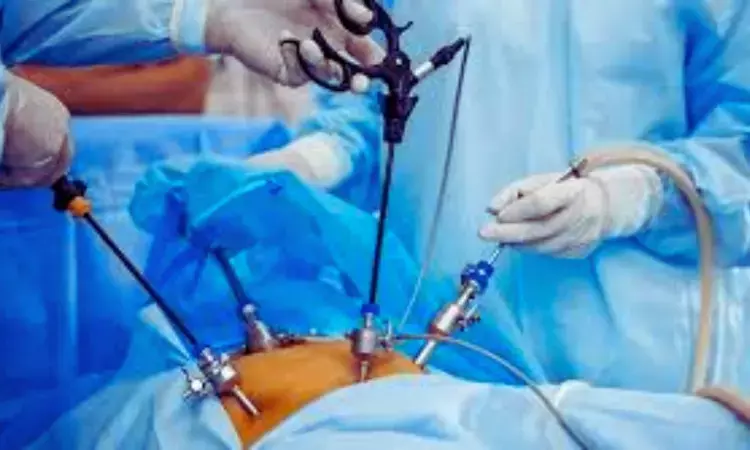- Home
- Medical news & Guidelines
- Anesthesiology
- Cardiology and CTVS
- Critical Care
- Dentistry
- Dermatology
- Diabetes and Endocrinology
- ENT
- Gastroenterology
- Medicine
- Nephrology
- Neurology
- Obstretics-Gynaecology
- Oncology
- Ophthalmology
- Orthopaedics
- Pediatrics-Neonatology
- Psychiatry
- Pulmonology
- Radiology
- Surgery
- Urology
- Laboratory Medicine
- Diet
- Nursing
- Paramedical
- Physiotherapy
- Health news
- Fact Check
- Bone Health Fact Check
- Brain Health Fact Check
- Cancer Related Fact Check
- Child Care Fact Check
- Dental and oral health fact check
- Diabetes and metabolic health fact check
- Diet and Nutrition Fact Check
- Eye and ENT Care Fact Check
- Fitness fact check
- Gut health fact check
- Heart health fact check
- Kidney health fact check
- Medical education fact check
- Men's health fact check
- Respiratory fact check
- Skin and hair care fact check
- Vaccine and Immunization fact check
- Women's health fact check
- AYUSH
- State News
- Andaman and Nicobar Islands
- Andhra Pradesh
- Arunachal Pradesh
- Assam
- Bihar
- Chandigarh
- Chattisgarh
- Dadra and Nagar Haveli
- Daman and Diu
- Delhi
- Goa
- Gujarat
- Haryana
- Himachal Pradesh
- Jammu & Kashmir
- Jharkhand
- Karnataka
- Kerala
- Ladakh
- Lakshadweep
- Madhya Pradesh
- Maharashtra
- Manipur
- Meghalaya
- Mizoram
- Nagaland
- Odisha
- Puducherry
- Punjab
- Rajasthan
- Sikkim
- Tamil Nadu
- Telangana
- Tripura
- Uttar Pradesh
- Uttrakhand
- West Bengal
- Medical Education
- Industry
Endoscopic Purse-String Suturing Proves Safe and Effective for Small ADAFs, Reveals Research

China: Endoscopic purse-string suturing is a safe, minimally invasive, and effective treatment for abdominal drain-associated fistulas (ADAFs), especially effective in small fistulas with openings ≤1 cm, a recent study has revealed.
In the study, published in BMC Surgery, Guangxu Zhu and colleagues from The First Affiliated Hospital of Shandong Second Medical University, Weifang, China, examined the role of endoscopic purse-string suturing in managing abdominal drain-associated fistulas following gastrointestinal surgery. These fistulas represent serious postoperative complications where conventional surgical reintervention can be highly invasive and associated with prolonged recovery times.
The retrospective cohort analysis included 41 patients with ADAFs treated between January 2015 and June 2024 at Shandong Second Medical University and affiliated referral centers. The primary goal was to assess the technical feasibility, clinical success, and safety profile of endoscopic purse-string suturing as a therapeutic option for these challenging postoperative complications.
The results were encouraging:
- Technical success, defined as proper deployment of the endoscopic suture, was achieved in 87.8% of patients (36/41).
- Clinical success, defined as complete resolution of the fistula, was observed in 63.4% of patients (26/41).
- Isolated ADAFs without concurrent anastomotic disruptions had significantly higher clinical success rates compared to cases with anastomotic complications (90.0% vs. 39.1%).
- Multivariate analysis identified preoperative anastomotic stenosis (OR = 0.083) as a factor associated with reduced therapeutic efficacy.
- Fistula orifice diameter greater than 1 cm (OR = 0.039) was also linked to lower clinical success.
- During a 12-month follow-up, no mortality or fistula recurrence was reported, indicating long-term durability of the procedure.
- Postprocedural anastomotic stenosis occurred in 4.9% of patients (2/41) and was successfully managed using endoscopic balloon dilation (n=1) and gastrointestinal stent placement (n=1).
The investigators concluded that endoscopic purse-string suturing is a safe and effective minimally invasive strategy for managing ADAFs, with optimal results observed in isolated drain-related fistulas with small orifices.
However, the study had certain limitations. Its retrospective design introduces potential selection and information biases, while the relatively small sample size may limit the statistical power to detect all clinically relevant differences. Moreover, there were no direct comparisons with alternative management strategies, such as traditional surgical repair or conservative treatment.
The authors emphasize that larger, prospective, multicenter studies are needed to better define clinical indications, evaluate long-term safety, and establish standardized postoperative follow-up protocols.
"The endoscopic purse-string suture technique offers a promising, minimally invasive option for managing drain-related fistulas after gastrointestinal surgery. It's significant clinical efficacy, particularly for small, isolated fistulas, along with a favorable safety profile, supports its consideration as a preferred therapeutic approach in suitable patients," the authors wrote.
Reference:
Zhu, G., Kong, L., Liu, X. et al. Endoscopic purse-string suture technique for postoperative drain-related leakage management in gastrointestinal surgery. BMC Surg 25, 439 (2025). https://doi.org/10.1186/s12893-025-03171-6
Dr Kamal Kant Kohli-MBBS, DTCD- a chest specialist with more than 30 years of practice and a flair for writing clinical articles, Dr Kamal Kant Kohli joined Medical Dialogues as a Chief Editor of Medical News. Besides writing articles, as an editor, he proofreads and verifies all the medical content published on Medical Dialogues including those coming from journals, studies,medical conferences,guidelines etc. Email: drkohli@medicaldialogues.in. Contact no. 011-43720751
Next Story


